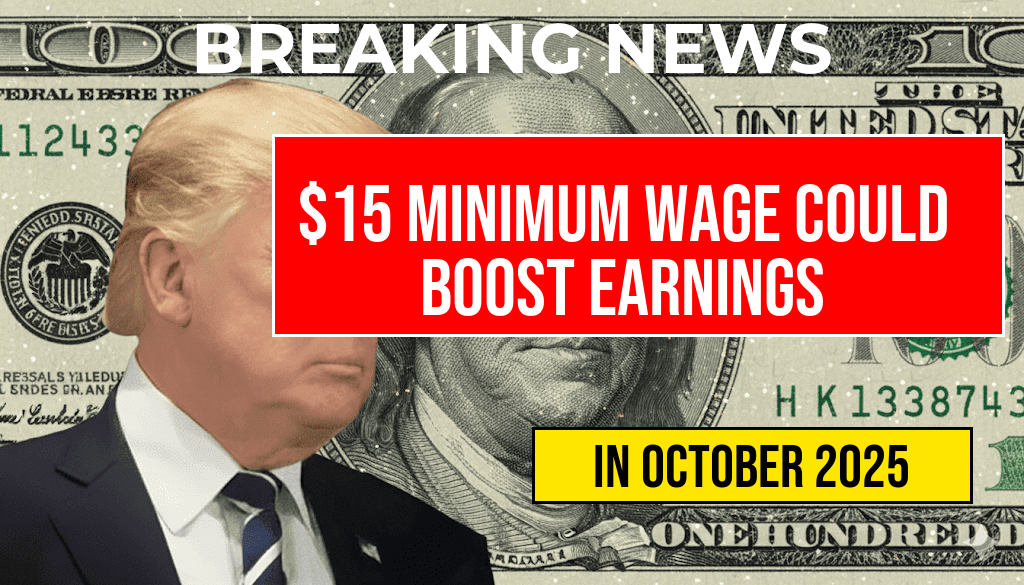A new study suggests that implementing a federal minimum wage of $15 an hour could significantly increase earnings for millions of American workers. Specifically, approximately 32 million employees could see their annual income rise by around $3,300. This increase would have meaningful implications for low-wage earners across diverse industries, potentially reducing economic disparities and boosting consumer spending. The findings arrive amid ongoing debates over the federal minimum wage’s adequacy and its broader impact on employment and economic growth.
Potential Economic Impact of a $15 Minimum Wage
Proponents argue that raising the federal minimum wage to $15 an hour would provide essential financial relief for millions of workers, many of whom struggle with stagnant wages amid rising living costs. Conversely, critics express concerns about potential job losses or increased automation in sectors heavily dependent on low-wage labor. The recent study, conducted by economists at the Urban Institute, offers a comprehensive analysis of the anticipated benefits, emphasizing the direct effect on individual earnings and broader economic activity.
Key Findings of the Study
| Number of Workers Affected | Average Annual Income Increase | Total Additional Earnings (millions) |
|---|---|---|
| 32 million | $3,300 | $105 billion |
The study estimates that nearly 32 million workers, representing a significant portion of the low-wage workforce, would see their annual earnings grow by approximately $3,300. This translates to a collective increase in income exceeding $105 billion annually, which could bolster local economies and improve quality of life for many families.
Demographic and Sector Breakdown
- Age groups: The most substantial gains are projected for workers aged 25-34, who constitute a large share of the minimum wage workforce.
- Industries impacted: Retail, hospitality, healthcare support, and food service sectors are expected to experience the highest increases in worker earnings.
- Geographic distribution: Urban areas and states with higher living costs would see more pronounced income boosts, although the federal policy aims to standardize wages nationwide.
Economic and Social Implications
Adjusting the minimum wage to $15 per hour could have multifaceted effects. Economists highlight that increased earnings may lead to higher consumer spending, which can stimulate local businesses and promote economic growth. According to the Wikipedia entry on economic growth, consumer expenditure constitutes a significant component of GDP, suggesting that wage increases could have positive ripple effects.
However, some industry groups warn about potential downsides, such as increased labor costs leading to price hikes or reduced employment opportunities. The study, while optimistic about income gains, emphasizes that the actual impact depends on how employers adapt and whether wage increases lead to shifts in employment levels.
Policy Context and Legislative Developments
The push for a $15 federal minimum wage gained momentum over the past decade, with several states and cities raising their minimum wages beyond the federal level. As of 2023, the federal minimum remains at $7.25, a figure established in 2009. Advocates for raising the wage argue that the current baseline no longer aligns with inflation-adjusted living costs, leading to increased poverty among low-wage workers.
Legislative proposals, such as the Raise the Wage Act, aim to gradually increase the federal minimum to $15 by 2025. While facing opposition in Congress, the ongoing debate underscores the importance of balancing economic growth with workers’ financial well-being.
Broader Perspectives and Future Outlook
Experts continue to analyze the long-term effects of such wage policies. A comprehensive review from the Forbes article on minimum wage impacts highlights that, although some sectors may experience short-term adjustments, the overall economic trajectory could benefit from increased income equality and enhanced consumer confidence.
Ultimately, the decision to implement a $15 federal minimum wage involves complex trade-offs. Still, the recent study underscores its potential to uplift millions of workers, providing tangible financial benefits that could ripple throughout the U.S. economy.
Frequently Asked Questions
What is the potential impact of raising the federal minimum wage to fifteen dollars?
Raising the federal minimum wage to fifteen dollars could increase annual earnings by approximately three thousand three hundred dollars for around thirty-two million workers.
How many workers could benefit from a higher federal minimum wage?
Approximately thirty-two million workers could see a boost in their annual earnings if the federal minimum wage is increased to fifteen dollars.
What are the potential economic benefits of increasing the minimum wage?
Increasing the federal minimum wage could lead to higher income for millions of workers, potentially boosting consumer spending and supporting economic growth.
Does the study suggest that all workers will benefit equally from the wage increase?
No, the study indicates that the benefits will primarily impact workers earning near or below the new minimum, while effects on higher-income earners may be limited.
Are there any potential drawbacks associated with raising the minimum wage to fifteen dollars?
While the study highlights positive earnings impacts, some concerns include potential cost increases for employers and impacts on employment levels, which are important to consider alongside the benefits.

Leave a Reply